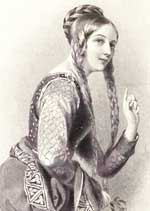Courtly Love - The Origin of Its Rules and Principles
The courtly love system originated in the South of France at a very early period. As early as the 11th century, several small courts were characterized by a brilliant society, in which woman held the supreme place. Under her influence, vast importance was attached to social etiquette and decorum. Definite rules governed the sexes in all their relations, especially in love.

Courtly love ideas were promoted by Eleanor of Aquitaine, here in a "Victorian" representation
It was to this society that the troubadours belonged, and it was chiefly love that was the inspiration of their songs. In the songs of the troubadours we find the earliest expression of the ideas of courtly love.
These ideas were introduced into northern France largely through the influence of Eleanor of Aquitaine. She took a lively interest in the doctrines as well as the practices of courtly love.
Before leaving her southern home to become Queen of France, she received, and, apparently, encouraged, advances of a very familiar nature from the troubadour Bernart de Ventadorn. At her new court in the North, she also lent her authority to the new doctrines.
She was followed by her daughter, Marie of Champagne, and other noble ladies, who amused themselves by rendering decisions on difficult questions which were argued before the mock Courts of Love. Soon, these decisions ended up being regarded as definite rules and regulations of the courtly system. Thus, in northern France, the new ideas received from the very beginning the sanction and support of high ranking women. Through their influence, these ideas found their way into contemporary literature.
Marie of Champagne, for instance, impressed them upon Chrétien de Troyes, and he introduced them into the romances of the Round Table. Under his hands, the Arthurian romances became the representatives par excellence of the chivalrous and courtly ideal of 12th century society. His Chevalier de la Charrette (The Knight of the Cart), which reflects in a special manner the conceptions of the courtly love, owes its existence, as Chrétien himself tells us, to Marie of Champagne.
The exaggerations employed to give a semblance of intensity to an artificial passion became poetical conventions, and it was with such material that Chrétien worked. His contribution to the courtly system consists in the romances of the Round Table or the Arthurian Cycle, where the ideas already present in the 12th century literature are complemented by his own.
The interest in courtly love is nowhere more clearly manifested than in certain works roughly contemporary with Chrétien, which treat love as an art, setting forth in a scientific manner the principles of the system and codifying the laws which governed the system. This method of treatment had its origin in the erotic writings of Ovid, the favorite poet of the Medieval schools. His Ars Amatoria was several times translated into French. The translations were altered in ways to suit the manners and customs of the medieval society, the sensualism of the original being interpreted according to the spirit of chivalry.
The crystallizing of courtly love sentiments was not due to Chrétien de Troyes alone. The process had begun in the poetry of the troubadours, for whom, as well, winning a woman’s heart was an art to be practised rather than a passion to be felt. The art of courtly love was largely a matter of behavior. The lover’s strict concern was to regulate his conduct in strict accord with the rules and restrictions of this new art.
In literature, in imitation of the apocalyptic writings of the Church, many erotic poems were cast in the form of visions. The love vision became a distinct literary type, and for a long time was the main mode of expressing the courtly love sentiment. Generally, the poems were telling the story of a hero in the service of passion. The events usually happen in spring, a season traditionally associated with romance. The hero is often conducted by a guide to the god of love, a deity of classical inspiration, a good example being the first elegy of Amores by Ovid.
The most important work of the period describing the principles and rules of the art of love is "De Arte Honeste Amandi" or "De Amore" by Andreas Capellanus, known sometimes by the French translation of his name as André le Chapelain. The work is usually translated in English as The Art of Courtly Love, even if, sometimes, the cynical tone makes it rather an antidote to the system and its rules.
The book of Andreas Capellanus provides us with the means of understanding the abstract principles and the laws underlying the courtly love system.

